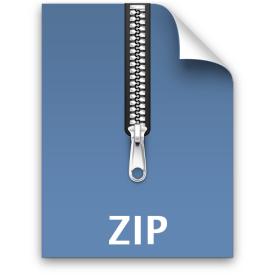Syllabus for “Frankenstein and Film” (Spring 2017).
Tag: film
Frankenstein@200
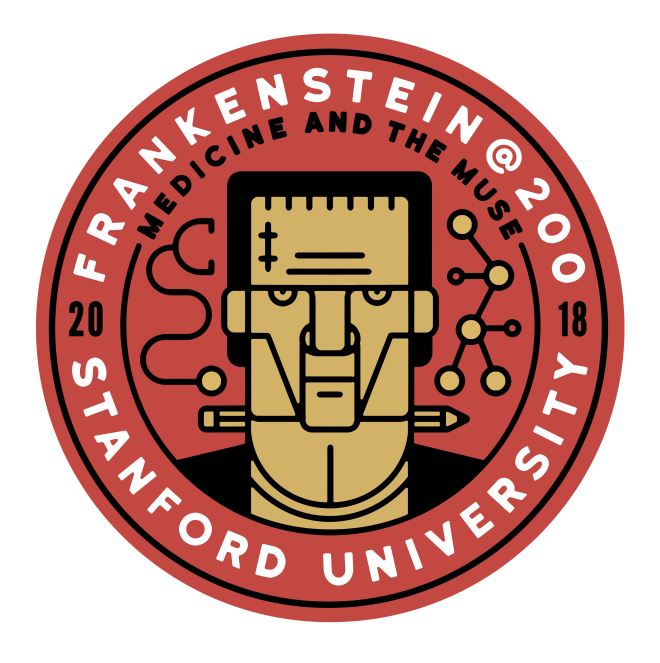
Happy to be on the steering committee for Frankenstein@200 — a year-long series of events taking place at Stanford in 2018. I’ll be participating in a number of ways, including talks and several courses related to Frankenstein, among other things. I’ll post details here in due time. Also be sure to check out the project website, which is still under construction, but which is already chock full of announcements and constantly being updated.
The year 2018 marks the 200th anniversary of the publishing of Mary Shelley’s novel Frankenstein. The novel is eerily relevant today as we face ethical dilemmas around appropriate use of stem cells, questions about organ donation and organ harvesting, as well as animal to human transplants. Additionally, the rise of artificial intelligence portends an uncertain future of the boundaries between machines and humans. Frankenstein@200, will be a year-long series of academic courses and programs including a film festival, a play, a lecture series and an international Health Humanities Conference that will examine the numerous moral, scientific, sociological, ethical and spiritual dimensions of the work, and why Dr. Frankenstein and his monster still capture the moral imagination today. This project will be sponsored by the Stanford Medicine & the Muse Program in partnership with the Stanford Humanities Center, the Stanford Arts Institute, the Office of Religious Life, the Vice Provost for Teaching and Learning, Stanford Continuing Studies, the Cantor Arts Center, the Department of Art & Art History, and the Center for Biomedical Ethics.
Animating Frankenstein (Stanford Graphic Narrative Project, Nov. 16, 2016)

This coming Wednesday (Nov. 16, 2016 at 6pm), I will be presenting a talk titled “Animating Frankenstein: Film, Comics, Visual Culture.” The event is organized by the Stanford Graphic Narrative Project (under the leadership of Mia Lewis and Scott Bukatman) and hosted by the Stanford Humanities Center. More info here.
Post-Cinema (Book Trailer)
Here is a short “book trailer” for the open-access collection Post-Cinema: Theorizing 21st-Century Film, edited by Shane Denson and Julia Leyda (REFRAME Books, 2016).
Also, don’t forget that we’ll be having a book launch party at Pro qm Books in Berlin this coming Friday, June 24. See here for more info and a flyer.
Out Now — Post-Cinema: Theorizing 21st-Century Film
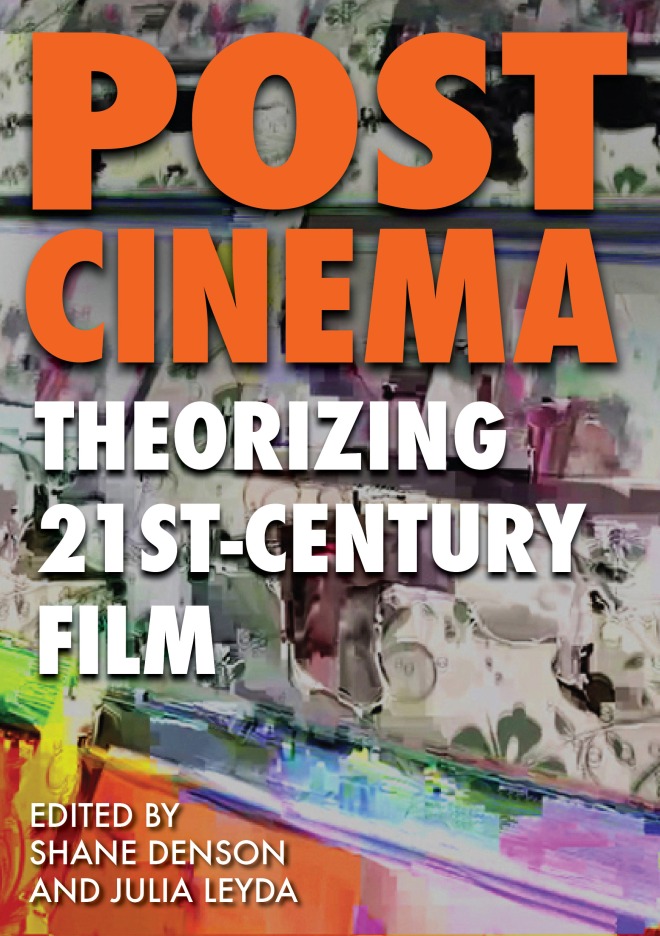
I am happy to announce, at long last, the publication of Post-Cinema: Theorizing 21st-Century Film, edited by Shane Denson and Julia Leyda, which is out today as a completely free and open-access volume with REFRAME Books.
If cinema and television, as the dominant media of the 20th century, shaped and reflected our cultural sensibilities, how do new digital media in the 21st century help to shape and reflect new forms of sensibility? In this collection, editors Shane Denson and Julia Leyda have gathered a range of essays that approach this question by way of a critical engagement with the notion of “post-cinema.” Contributors explore key experiential, technological, political, historical, and ecological aspects of the transition from a cinematic to a post-cinematic media regime and articulate both continuities and disjunctures between film’s first and second centuries.
The book will appear in several digital formats: the web-based version is online today, and several ebook formats will be appearing soon.
The book brings together foundational texts by some of the key voices in the discussion of post-cinema and places them next to a range of brand-new chapters, as well as a series of roundtable discussions.
The long list of contributors includes:
Caitlin Benson-Allott, Paul Bowman, Felix Brinker, Kristopher L. Cannon, Francesco Casetti, Steen Christiansen, Elena del Río, Shane Denson, Rosalind Galt, Therese Grisham, Richard Grusin, Leon Gurevitch, Mark B. N. Hansen, Bruce Isaacs, Adrian Ivakhiv, Kylie Jarrett, Selmin Kara, Julia Leyda, Patricia MacCormack, Lev Manovich, Ruth Mayer, Michael O’Rourke, Patricia Pisters, Alessandra Raengo, David Rambo, Nicholas Rombes, Sergi Sánchez, Karin Sellberg, Steven Shaviro, Michael Loren Siegel, Vivian Sobchack, Billy Stevenson, Andreas Sudmann
Here is the table of contents:
A brief “press release” with a description of the book and the complete table of contents is available here (opens as a PDF): POST-CINEMA-Press-Release
Post-Cinematic Affect, Collectivity, and Environmental Agency #scms16
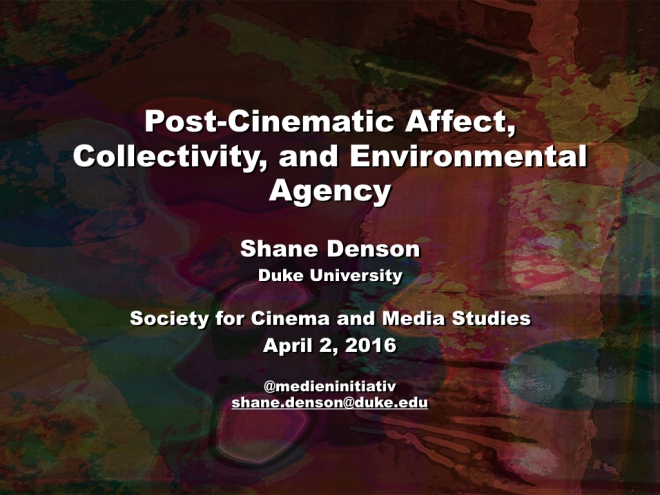
Full text of the talk I presented at the SCMS conference today:
Post-Cinematic Affect, Collectivity, and Environmental Agency
Shane Denson (Duke University)
The computational and broadly post-cinematic media at the heart of contemporary moving images are involved in a massive transformation of human agents’ phenomenological relations to the world. Digital imagery has long been held accountable for effacing the indexicality of cinema’s photographic base, while post-cinematic images more generally might be thought in terms of what I call their “discorrelation” from viewing subjects. However, there is a flip-side to these negative determinations that I want to highlight: if the microtemporal and subperceptual operations of post-cinematic media bypass and hence displace subjective perception, they also serve to expand the material domain and efficacy of sub- and supra-personal affect. What this amounts to, ultimately, is a radical empowerment of the nonhuman environment, the agency of which becomes tangible in sites and forms ranging from the Fitbit to “big data” and the computational modeling of climate change.
In this presentation, which is divided into three sections, I want to take this thought a step further. I want to show, ultimately, that new forms of collectivity may become thinkable and, hopefully, actionable in the spaces opened up by post-cinematic media.
Part 1: Irrational Cameras. Let me start by summarizing an argument I have made elsewhere about the transformation of the camera and its images in a post-cinematic media regime. Post-cinematic cameras – by which I mean a range of imaging apparatuses, both physical and virtual – seem not to know their place with respect to the separation of diegetic and nondiegetic planes of reality; these cameras therefore fail to situate viewers in a consistently and coherently designated spectating-position.
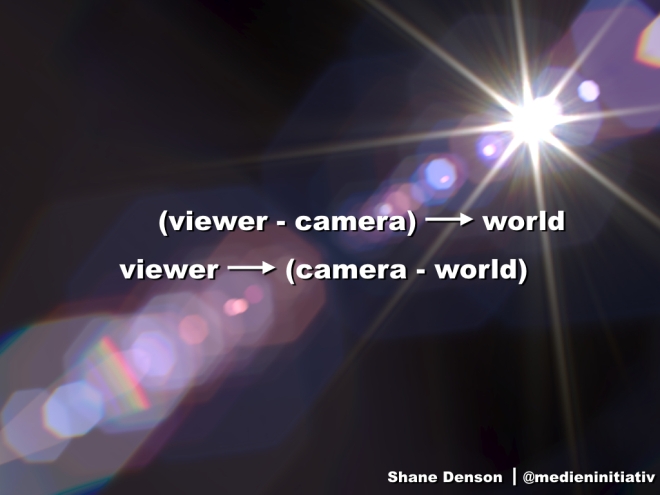
Take the example of the digitally simulated lens flare, which a phenomenological analysis reveals to be riddled with perceptual paradoxes. On the one hand, the CGI lens flare encourages what philosopher of technology Don Ihde calls an “embodiment relation” to the virtual camera: by simulating the material interplay of a lens and a light source, the lens flare emphasizes the plastic reality of “pro-filmic” CGI objects; the virtual camera itself is to this extent grafted onto the subjective pole of the intentional relation, “embodied” in a sort of phenomenological symbiosis that channels perception towards the objects of our visual attention. On the other hand, however, the lens flare draws attention to itself and highlights the images’ artificiality by emulating (and foregrounding the emulation of) the material presence of a camera. To this extent, the camera is rendered quasi-objective, and it instantiates what Ihde calls a “hermeneutic relation”: we look at the camera rather than just through it, and we interpret it as a sign or token of “realisticness.”
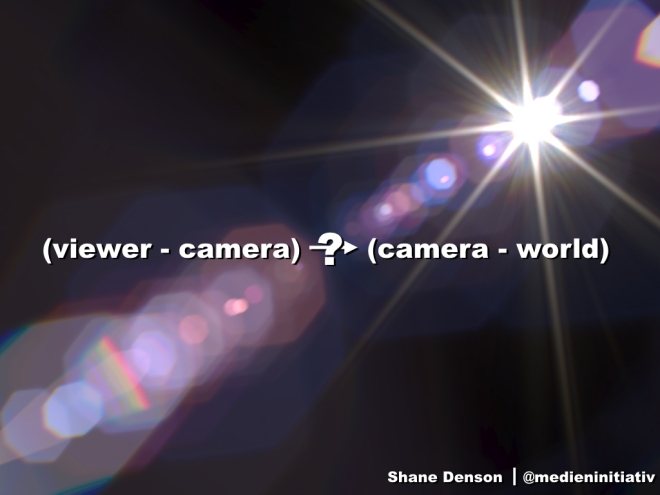
The paradox here, which consists in the realism-constituting and realism-problematizing undecidability of the virtual camera’s relation to the diegesis – where the “reality” of this realism is conceived as thoroughly mediated, the product of a simulated physical camera rather than defined as the hallmark of embodied perceptual immediacy – points to a more basic transformation of mediation itself in the post-cinematic era. That is, the undecidable place of the mediating apparatus, the camera’s apparently simultaneous occupation of both subjective and objective positions within the noetic relation that it enables between viewers and the film, is symptomatic of a more general destabilization of phenomenological subject- and object-positions in relation to the expanded affective realm of post-cinematic mediation. Computational, ergodic, and processual in nature, media in this mode operate on a level that is categorically beyond the purview of perception, perspective, or intentionality. Phenomenological analysis can therefore provide only a negative determination “from the outside”: it can help us to identify moments of dysfunction or disconnection, but it can offer no positive characterization of the “molecular” changes occasioning them. Thus, for example, CGI and digital cameras do not just sever the ties of indexicality that characterized analogue cinematography (an epistemological or phenomenological claim); they also render images themselves fundamentally processual, thus displacing the film-as-object-of-perception and uprooting the spectator-as-perceiving-subject – in effect, enveloping both in an epistemologically indeterminate but materially quite real and concrete field of affective relation. Mediation, I suggest, can no longer be situated neatly between the poles of subject and object, as it swells with processual affectivity to engulf both.

Part 2: The dilation of affect. What I have been describing here is a decentering of human perception and an empowerment of the larger environment. In order to account for this transformation, it will be helpful here to invoke Mark Hansen’s notion of “atmospheric media,” a concept that Hansen develops to explain the experiential impact of computation, but which builds upon Maurizio Lazzarato’s theorization of an affective dimension of video technologies.
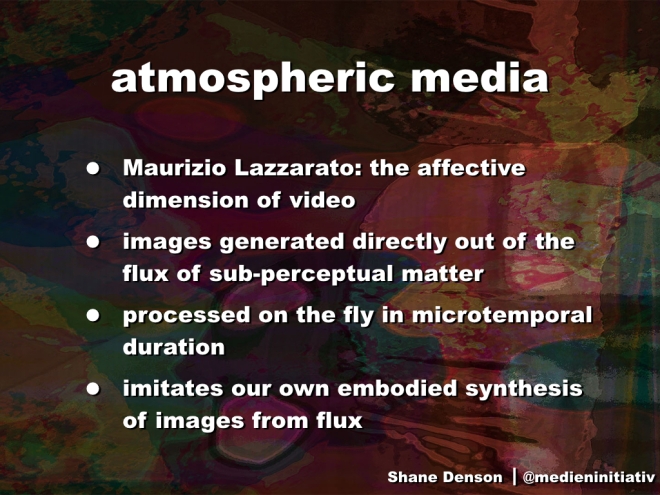
According to Lazzarato, the video camera captures time itself, the splitting of time at every instant, hence opening the gap between perception and action where affect resides (in the metaphysics of Henri Bergson). Because it no longer merely traces objects mechanically and fixes them as discrete photographic entities, but instead generates its images directly out of the flux of sub-perceptual matter, which it processes on the fly in the space of a microtemporal duration, the video camera marks a revolutionary transformation in the technical organization of time. The mediating technology itself becomes an active locus of molecular change: a Bergsonian body qua center of indetermination, a gap of affectivity between passive receptivity and its passage into action. The camera imitates the process by which our own pre-personal bodies synthesize the passage from molecular to molar, replicating the very process by which signal patterns are selected from the flux and made to coalesce into determinate images that can be incorporated into an emergent subjectivity.
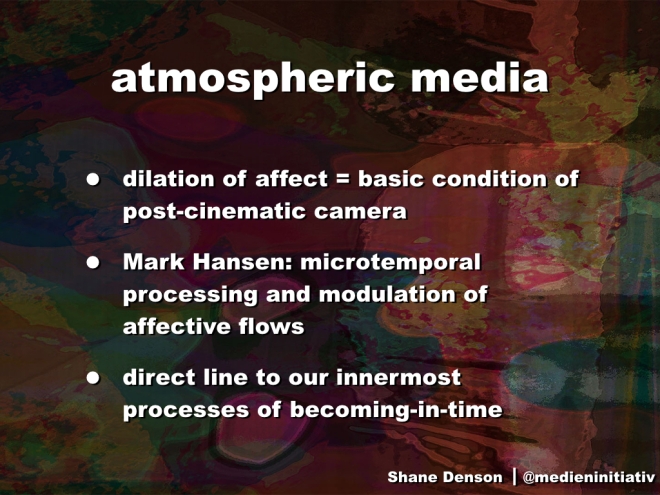
This dilation of affect, which characterizes not only video but also computational processes like the rendering of digital images (which is always done on the fly), marks the basic condition of the post-cinematic camera, the positive underside of what presents itself externally as a discorrelating incommensurability with respect to molar perception. As Mark Hansen has argued, the microtemporal scale at which computational media operate enables them to modulate the temporal and affective flows of life and to affect us directly at the level of our pre-personal embodiment. In this respect, properly post-cinematic cameras, which include video and digital imaging devices of all sorts, have a direct line to our innermost processes of becoming-in-time, and they are therefore capable of informing the political life of the collective by flowing into the “general intellect” at the heart of immaterial or affective labor. Again, this is because the individual’s capacity to perceive is decentered, discorrelated from the perceptual object, and offloaded onto an environment of diffusely “atmospheric” media – including the many screens and cameras, but also the invisible networks and data streams, that surround us everywhere.
Part 3: Post-Cinematic Realism. Paradoxically, these arguments suggest that post-cinematic media – precisely those media widely credited with destroying the index and thus evacuating the political promise of realism – might in fact be credited with a newly intensified political relevance through their institution of a new, post-cinematic realism.
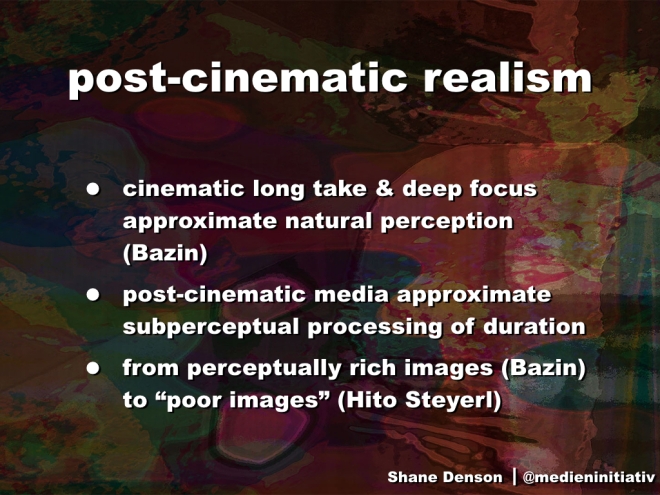
Whereas Bazin privileged techniques like the long take and deep focus for their power to approximate our natural perception of time and space, Lazzarato and Hansen emphasize post-cinematic media’s ability to approximate the sub-perceptual processing of duration executed by our pre-personal bodies. The perceptual discorrelation of images gives way, in other words, to a more precise calibration of machinic and embodied temporalities; simultaneously, the perceptual richness of Bazin’s images becomes less important, while “poor images” (in Hito Steyerl’s term) communicate more directly the material and political realities of a post-cinematic environment.
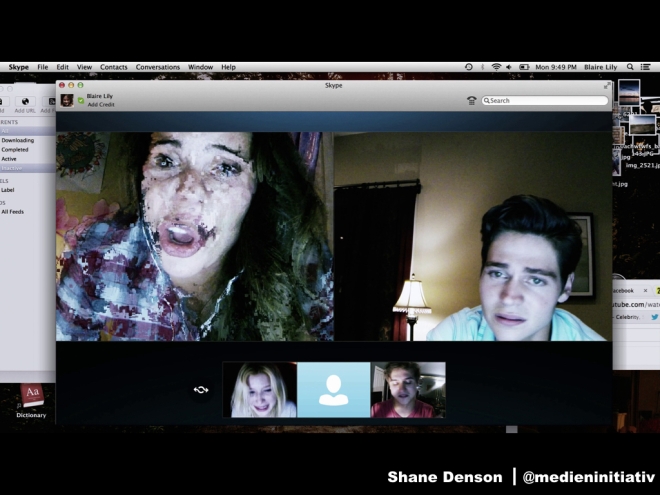
Consider the 2015 horror flick Unfriended, which is presented as the screen recording of one of the characters’ laptops. Reflecting what Francesco Casetti calls the “relocation” of cinema from the big screen to a variety of little ones, the movie’s sense of “realism” is especially heightened when you watch it on your own laptop. We witness everything on this single screen, through Skype conversations, Facebook chats, email, and web browsing. And it’s essential for the movie that it’s presented in “real-time.” This adds to the temporal urgency and speaks to the reality of our own online communications today, thereby establishing a sense of realism despite the fantastic/supernatural elements at play, and articulating this reality despite—or precisely through—the use of digital glitches. These might otherwise be taken to signal the interruption of realism by the intercession of digital processing that breaks the indexical continuity between image input and image output, but such glitches are a familiar reality of online communication (on platforms like Skype), and our involvement in the images is increased by their use; for example, we might wonder whether the glitches are diegetic, or whether they are produced on our own machine during playback, either due to the buffering processes of online streaming platforms, or because we downloaded a faulty torrent file from some dubious website. Realism here is constructed through an immediacy and direct exploration of the new media-technical conditions of life, to which we can all more or less relate. But in the process the glitches also expose the movie’s singular screen as, in fact, double: the site of playback, traditionally a passive “screening” surface, the screen is also revealed as a newly active site or space in which images are processed and generated before our very eyes. The glitches point up the perceptual paradoxes of post-cinematic cameras, as I’ve described them with respect to CGI lens flares, but they additionally implicate the post-cinematic screen, which becomes ontologically indistinguishable from the camera in its execution of the same material processes of microtemporal and subperceptual image generation.
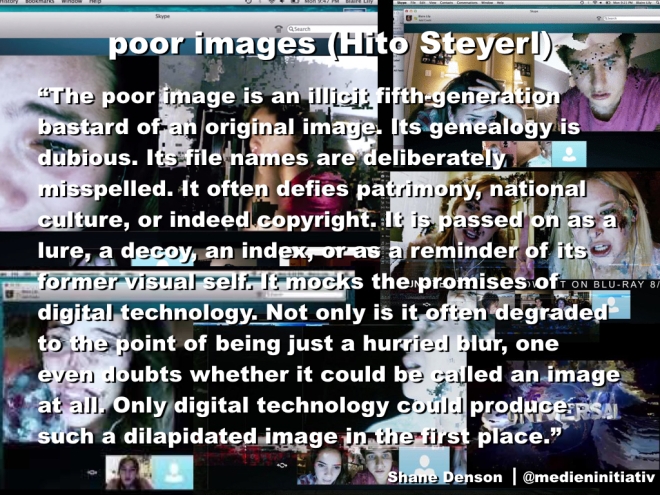
These glitches, and their relation to our contemporary media-technical realities, call attention to what Hito Steyerl has called the “poor images” that circulate in digital networks. Following Steyerl, these images provide an important context for thinking about the political realities of moving-image media today—and an important context for thinking about post-cinematic realism more generally. In Steyerl’s words: “The poor image is an illicit fifth-generation bastard of an original image. Its genealogy is dubious. Its file names are deliberately misspelled. It often defies patrimony, national culture, or indeed copyright. It is passed on as a lure, a decoy, an index, or as a reminder of its former visual self. It mocks the promises of digital technology. Not only is it often degraded to the point of being just a hurried blur, one even doubts whether it could be called an image at all. Only digital technology could produce such a dilapidated image in the first place.” These poor images are close in spirit to the “imperfect cinema” called for in the name of Third Cinema movements, in that they register social marginalization processes while also creating publics of their own. But they also outline the dark side of a “participatory culture,” whose democratic promise is compromised by the hierarchies of value that remain and by the exploitation of unpaid fan labor that is enlisted in the ongoing production-consumption circuits of networked images. Without extracting themselves from these conflicting political trajectories, according to Steyerl, poor images might nevertheless—or precisely for this reason—create what Dziga Vertov called “visual bonds” capable of subverting official and mainstream valuations by expressing what Steyerl terms a “link to the present.” In this way, degraded, glitched-out images might fulfill the political promise of realism precisely through their material connection to the post-indexical infrastructures of moving-image media. In Steyerl’s words: “The poor image is no longer about the real thing—the originary original. Instead, it is about its own real conditions of existence: about swarm circulation, digital dispersion, fractured and flexible temporalities. It is about defiance and appropriation just as it is about conformism and exploitation. In short: it is about reality.”
Like Steyerl, Lazzarato also refers to Vertov and his idea of the “visual bond,” which is seen as a materialist alternative to the critique of ideology, the expression of a practice that addresses the ontology of media directly and prior to the level of content. Essentially, by resisting reduction to human perception, the images of Vertov’s kino-eye are discorrelated from molar experience but thereby opened to the molecular processes by which duration is processed both biologically and technologically, thus getting to the heart of the process by which subjectivities and social collectives are produced. If Bazin described a cinematic realism that draws for its political power on an approximation to perceptual experience, then Vertov marks the path towards a post-cinematic realism that takes aim at the process by which the subject of that perceptual experience takes shape in the first place. It does this, according to Lazzarato, by means of the pre-personal affect that is marshaled and modulated by the increasingly fine-grained “time-crystallizing machines” of cinema, video, and digital processors. Accordingly, the video art of Nam June Paik is seen as a Vertovian answer to television, not because it counters the ideological content of TV but because it probes the machinic time itself of the apparatus, freeing it from the exclusive control of state and corporate interests. The latter, according to Lazzarato, contribute to the production and regulation of political subjects through their control of technical standards (like the PAL and NTSC standards that regulate image frequency, color spectrum, and aspect ratio); because the power to modulate the speeds and images dictated by such standards is “withdrawn from social praxis” (78), our affective powers are impoverished, and we are left with what Lazzarato calls a “‘poor’ perception” (78). The ontology of time-crystallizing machines thus gives way to an ethics or politics of the standards, codes, or protocols upon which images or perceptual objects are formed and synchronized with emergent subjects and social collectives. And because they expose the materiality of digital file formats, video codecs, and compression algorithms, today’s poor images harbor a significant political promise, a potential for resistance that can be deployed creatively against the impoverishment and standardization of perception.

It is debatable, finally, whether a movie like Unfriended actually succeeds in this respect. Certainly, at the level of its narrative, it apparently fails to articulate anything like a model of social-political resistance; if anything, its teenage drama of betrayal, suicide, and revenge, all mediated by the networks and interfaces of social media, and leading to the death of the entire group of “friends,” serves as a critique of contemporary socialization processes – an ideological critique that takes aim not only at online bullying, for example, but that exposes an infrastructure of communication and of intersubjective relation that has rendered the term “friend” itself highly unstable in the age of Facebook. But beyond this more overt political critique of today’s highly mediated forms of collectivity, the movie’s use of glitches serves to focus attention, and to channel affect, at a deeper level, where subjectivity itself is being produced and modulated in an environment of microtemporally operating machines and protocols. Glitches serve at times like micro-cliffhangers, causing us to wait for the image to buffer or clear up so that we can see what’s going on. In this respect, the movie simulates the familiar and yet always disconcerting experience of network lag, e.g. in our own Skype conversations, when the temporal continuity of protentional-retentional experience is interrupted, giving rise to a feeling like that of a cartoon character who has gone over the edge of a cliff, but remains suspended, floating momentarily between the certainty of solid ground and a realization of the situation’s gravity. These micro-cliffhangers focus our attention on the material infrastructure of experience itself, causing us to see pixels as the components but also as material obstacles to vision, blocky screen objects that, despite ourselves, we try to look around to see what’s on the other side. And in this space of the screen, seemingly unitary but, as we have seen, doubled and in fact multiplied even further by the machinic and social networks in which it participates (both diegetically and materially), our vision is dispersed, divided. We are forced to scan the screen for relevant information; our gaze is not sutured, not directed, and to this extent we are hailed not as an integral subject, but as a bundle of affects engaged in a collective effort to perceive—an effort that is both enabled and hindered by the protocols and agencies of the media environment, out of which our subjectivities are wrought. Unfriended may or may not ultimately facilitate our efforts to take control of this experiential infrastructure, but perhaps it succeeds in gesturing towards the fact that this effort must be a collective one, aimed at constructing collectivity in the first place, and that it must be mounted around and in relation to the affective technologies of our post-cinematic environment.
Interactivity and the “Video Essay”
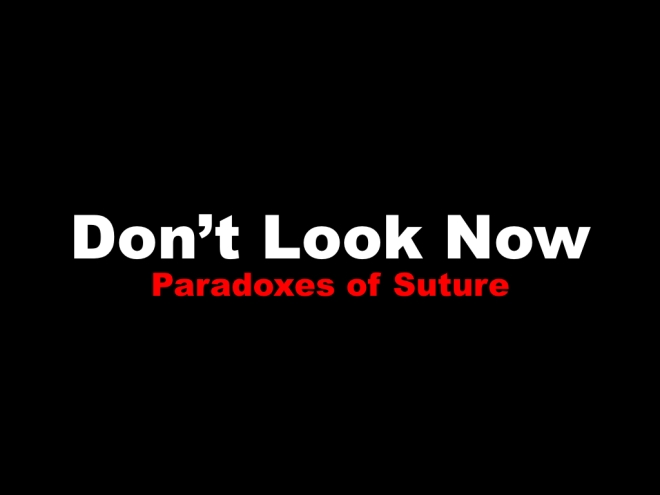
Recently, I posted a video essay exploring suture, space, and vision in a scene from Nicholas Roeg’s Don’t Look Now (1973). Following my video essay hijab.key, which experimented with dirt-cheap DIY production (namely, using Apple’s Keynote presentation software instead of the much more expensive Adobe Premiere Pro or Final Cut Pro for video authoring), the more recent video, “Don’t Look Now: Paradoxes of Suture,” was also an experiment in using splitscreen techniques for deformative purposes, intended to allow the viewer to alternate between “close” (or focused) and “distant” (or scanning, scattered) viewing modes.
What I have begun to realize, however, is that these videos are pushing at the boundaries of what a “video essay” is or can be. And I think they are doing so in a way that goes beyond the more common dissatisfactions that many of us have with the term “video essay” — namely, the questionable implications of (and formal expectations invoked by) the term “essay,” which apparently fails to describe many videographic forms that are either more poetic in nature or that indeed try to do argumentative or scholarly work, but whose arguments are less linear or explicit than those of traditional essays. These are good reasons, I think, to prefer a term like “videographic criticism” (except that “criticism” is perhaps too narrow) or “videographic scholarship” over the more common “video essay.”
But these recent pieces raise issues that go beyond such concerns, I suggest. They challenge the “videographic” part of the equation as much as, or even more than, the “essayistic” part. Take my “Don’t Look Now” video, which as I stated is designed to give the viewer the opportunity to experiment with different ways or modes of looking. By dissecting a scene into its constituent shots and laying them out in a multiscreen format, I wanted to allow the viewer to approach the scene the way one looks at a page of comics; that is, the viewer is free to zoom into a particular panel (which in this case is a looping video clip) and become immersed in the spatiotemporal relations it describes, only then to zoom back out to regard a sequence, row, or page of such panels, before zooming back in to the next one, and so on. Thus, two segments in the recent video consist simply of fifteen looping shots, laid out side by side; they are intended to give the viewer time to experiment with this other, less linear mode of looking.
But the video format itself is linear, which raises problems for any such experiment. For example, how long should such a splitscreen configuration be allowed to run? Any answer will be arbitrary. What is the duration of a page of comics? The question is not nonsensical, as cartoonists can establish rhythms and pacings that will help to determine the psychological, structural, or empirical duration of the reading experience, but this will never be an absolute and determinate value, as it is of necessity in the medium of video. That is, the linear format of video forced me to make a decision about the length of these segments, and I chose, somewhat arbitrarily, to give the viewer first a brief (30 sec.) glance at the multiscreen composition, followed later (after a more explicitly argumentative section) by a longer look (2 min. at the end of the 9 minute video). But since the whole point was to enable a non-linear viewing experience (like the non-linear experience of reading comics), any decision involving such a linearization was bound to be unsatisfactory.
One viewer commented, for example:
“I think the theory is interesting but why the lengthy stretches of multi shot with audio? Irritating to the extent that they detract from your message.”
Two important aspects come together in this comment. For one thing, the video is seen as a vehicle for a message, an argument; in short, it is regarded as an “essay.” And since the essayistic impulse combines with the video medium to impose a linear form on something intended as a non-linear and less-than-argumentative experimental setup, it is all too understandable that the “lengthy stretches” were found “irritating” and beside the point. I responded:
“For me the theory [of suture] is less interesting than the reading/viewing technique enabled by the splitscreen. I wanted to give the viewer time to make his or her own connections/alternate readings. I realize that’s at odds with the linear course of an ‘essay,’ and the length of these sections is arbitrary. In the end I may try to switch to an interactive format that would allow the viewer to decide when to move on.”
It was dawning on me, in other words, that by transforming the Keynote presentation into a video essay (using screen recording software), I had indeed found an interesting alternative to expensive video authoring software (which might be particularly valuable for students and other people lacking in funding or institutional support); at the same time, however, I was unduly amputating the interactive affordances of the medium that I was working in. If I wanted to encourage a truly experimental form of vision, then I would need to take advantage of precisely these interactive capabilities.
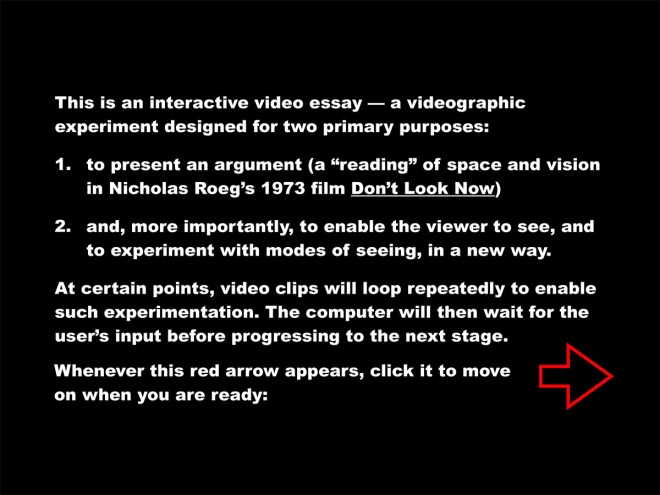
Basically, a Keynote file (like a PowerPoint presentation) is already an interactive file. Usually the interactivity is restricted to the rudimentary “click-to-proceed-to-the-next-slide” variety, but more complex and interesting forms of interaction (or automation) can be programmed in as well. In this case, I set up the presentation in such a way as to time certain events (making the automatic move from one slide to another a more “cinematic” sequence, for example), while waiting for user input for others (for example, giving the user the time to experiment with the splitscreen setup for as long as they like before moving on). You can download the autoplaying Keynote file (124 MB) here (or by clicking on the icon below) to see for yourself.
Of course, only users of Apple computers will be able to view the Keynote file, which is a serious limitation; ideally, an interactive video essay (or whatever we decide to call it) will not only be platform agnostic but also accessible online. Interestingly, Keynote offers the option to export your slideshow to HTML. The export is a bit buggy (see “known bugs” below), but with some tinkering you can get some decent results. Click here to see a web-based version of the same interactive piece. (Again, however, note the “known bugs” below.)
In any case, this is just a first foray. Keynote is probably not the ultimate tool for this kind of work, and I am actively exploring alternatives at the moment. But it is interesting, to say the least, to test the limits of the software for the purposes of web authoring (hint: the limits are many, and there is constant need for workarounds). It might especially be of interest to those without any web design experience, or in cases where you want to quickly put together a prototype of an interactive “essay” — but ultimately, we will need to move on to more sophisticated tools and platforms.
I am interested, finally — and foremost — in getting some feedback on what is working and what’s not in this experiment. I am interested both in technical glitches and in suggestions for making the experience of interacting with the piece more effective and engaging. In addition to the Keynote file and the online version, you can also download the complete HTML package as a single .zip file (66 MB), which will likely run smoother on your machine and also allow you to dissect the HTML and Javascript if you’re so inclined.
However you access the piece, please leave a comment if you notice bugs or have any suggestions!
Known bugs, limitations, and workarounds:
- Keynote file only runs on Mac (workaround: access HTML version)
- Buggy browser support for HTML version:
- Horrible font rendering in Firefox (“Arial Black” rendered as serif font)
- Offline playback not supported in Google Chrome
- Best support on Apple Safari (Internet Explorer not tested)
- Haven’t yet found the sweet spot for video compression (loading times may be too long for smooth online playback)
Postnaturalism reviewed in LWU
 The latest issue of Literatur in Wissenschaft und Unterricht, a special (English-language) issue on Serial Narratives edited by Kathleen Loock (a fellow member of the DFG research unit on “Popular Seriality”), includes a review of my book Postnaturalism: Frankenstein, Film, and the Anthropotechnical Interface.
The latest issue of Literatur in Wissenschaft und Unterricht, a special (English-language) issue on Serial Narratives edited by Kathleen Loock (a fellow member of the DFG research unit on “Popular Seriality”), includes a review of my book Postnaturalism: Frankenstein, Film, and the Anthropotechnical Interface.
The review, by Dennis Büscher-Ulbrich of the University of Kiel, is mostly positive, though hardly uncritical. You can read the entire review here, but my favorite part must be a certain characterization of the book that appears in the midst of exposing what Büscher-Ulbrich takes as “the book’s theoretical Achilles’ heel” (namely, my lack of engagement with overtly political revolutions and with “recent post-Marxist political ontologies and metaphysics” in particular). In this context, Büscher-Ulbrich nonetheless flatteringly praises my “extraordinary powers of theoretical synthesis” and claims that
“[Postnaturalism] is one of the rare enough scholarly monographs whose collected footnotes alone provide an excellent education.”
Now, I recognize that it’s not for everyone (I have been criticized before for including “an entire second essay within an essay”) — and while I’m not sure I’d recommend taking your kids out of school and making Postnaturalism the primary textbook for their homeschooling (though you might do worse…) — I’m glad to see the footnotes getting some attention here from a reader who can appreciate the value of a page of text “below the line.”
In any case, if Postnaturalism ever sees a second edition, I’ll certainly suggest this as a fitting blurb!
Check out the entire review:
- Büscher-Ulbrich, Dennis. Review of Postnaturalism: Frankenstein, Film, and the Anthropotechnical Interface, by Shane Denson. Serial Narratives. Special issue of Literatur in Wissenschaft und Unterricht 47.1-2 (2014), edited by Kathleen Loock.
And check out the entire special issue of LWU on Serial Narratives!
Complete Panel Video — Post-Cinema and/as Speculative Media Theory #SCMS15
On March 27, 2015, at the annual conference of the Society for Cinema and Media Studies in Montreal, Steven Shaviro, Patricia Pisters, Adrian Ivakhiv, and Mark B. N. Hansen participated in a panel I organized on “Post-Cinema and/as Speculative Media Theory.” It was standing room only, and many people were unable to squeeze into the room (some images are posted here). Thankfully, all of the presenters agreed to have their talks recorded on video and archived online.
(I have posted these videos here before, but for the sake of convenience I wanted to pull them together in a single post, so that the entire panel is available in one place.)
Above, you’ll find my brief general introduction to the panel, and below the four presentations:
Steven Shaviro’s proposal for a “Cinema 3.0”: the rhythm-image (following Deleuze’s movement-image and time-image)
Patricia Pisters, whose own proposal for a third image-type she calls the “neuro-image,” on the politics of post-cinema
Adrian Ivakhiv on the material, ecological dimensions of (post-)cinema in the Anthropocene and/or Capitalocene
Mark B. N. Hansen on the microtemporal and sub-perceptual dimensions of digital, post-cinematic images
Finally, you can look forward to hearing more from the panel participants, all of whom are contributing to an open-access collection titled Post-Cinema: Theorizing 21st-Century Film, co-edited by myself and Julia Leyda (forthcoming this year from REFRAME Books). More details soon, so stay tuned!
Frankenstein 1910 Glitch Mix
Video meditation inspired by the final paragraph of my book Postnaturalism:
Recoding our perceptions of the Frankenstein film, including even our view of Karloff’s iconic monster as the “original” of its type, Edison’s Frankenstein joins the ranks of the Frankenstein film series, now situating itself at our end rather than at the beginning of that series’ history. Now, prospering among the short clips of YouTube, where it is far more at home than any of the feature films ever could be, the Edison monster becomes capable again of articulating a “medial” narrative—a tale told from a middle altitude, from a position half-way between the diegetic story, on the one hand, of the monster’s defeat by a Frankenstein who grows up and “comes to his senses” and, on the other hand, a non-diegetic, media-historical metanarrative that, in contrast to the story of medial maturation it encoded in 1910, now articulates a tale of visual media’s currently conflicted state, caught between historical specificity and an eternal recurrence of the same. The monster’s medial narrative communicates with our own medial position, mediates possible transactions in a realm of experimentation, in which human and nonhuman agencies negotiate the terms of their changing relations. With its digitally scarred body, pocked by pixels and compression “artifacts,” the century-old monster opens a line of flight that, if we follow it, might bring us face to face with the molecular becoming of our own postnatural future.



